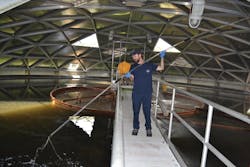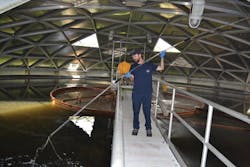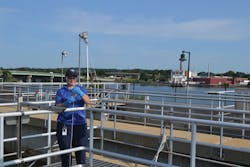The Maine Road to a Water Career
Whether you call it a boom or ‘silver tsunami,’ a major wave of retirements is underway. In fact, it’s estimated that 10,000 people turn 65 every single day, and that trend is expected to continue through 2030.
Many water and wastewater professionals have dedicated decades of their lives to collecting, distributing, and treating water. Their departure from the industry will leave a gaping hole to fill as years of experience and historical knowledge go with them. Attracting new talent to the industry is critical.
Apprenticeship programs are one way to help new entrants get their feet wet (pun intended) in the water and wastewater sector. Programs are popping up across the country and they come in all shapes and sizes. One example, developed by the Portland (Maine) Water District (PWD), is having great success — and is benefiting not only newbies but current employees as well. Scott Firmin, PWD’s director of wastewater services, sat down with us to explain.
Apprentices cycle through several different plants and job functions as part of PWD’s program. Photo courtesy Portland Water District.
WATERWORLD:You’ve been very active with your workforce development efforts. Tell us about what you’ve been doing?
SCOTT FIRMIN: For about the past 8 years, we’ve had an apprentice program where it’s allowing us to bring in a diverse talent pool and then give them specific education and instruction on what we do, exposure to what we do. And that allows them time to get their wastewater license and it allows us to bring in talented people who are excited about the field, but they also bring a varied talent or skillset with them to our programs.
WW:How did the program come about?
SF: Well, the average age of the wastewater group when we started this was 62 years. We’ve got roughly 40 employees in our department. Now, the water side started this program a few years before we did and we essentially stole the idea from them. [We] dedicated four of our 40 positions to this training program. So, about 10 percent of our staff.
WW: Have you seen the average age of your workforce coming down?
SF: Well, it’s interesting because a lot of people, when they think about replacing our retiring workers, think of a younger person, maybe right out of school. But our experience has been we’re getting a lot of people who are mid-career or even towards the end of their career that are just seeing a different opportunity. So, we’ve had a lot of people come in that aren’t necessarily younger but they’re great candidates.
WW: How does the program work?
SF: We’ll take candidates once they’re hired (we’ve got the four positions), and each candidate will spend three months at our largest plant, three months at our other three plants, three months in our sewer system group, two months in our engineering group learning about asset management, and then about five weeks (of half days) in our lab. So they’re learning all the areas of what we do. Then we also cycle them through the water side for a couple of weeks so they get to see that side of the business. So, what we’re finding is that when opportunities for promotion come up, we’ve got employees that really understand all of what we do and they’re able to move up into positions. And even if they specialize in our collection systems, they have an appreciation for the treatment plants. We’ve replaced about half of our operators who have either left or retired with people who have graduated or moved up from this program.
The program allows PWD to bring in and educate a diverse pool of talent. Photo courtesy Portland Water District.
WW: That must provide some peace of mind. You have a nice, well-rounded group of people who can step in for each other.
SF: We do. And it’s not just the training program; they’re also actively engaged in what we’re doing. Once they get familiar with things, they move from a strictly training aspect to, by the end of their time in collection systems, they’re actually doing productive work.
WW:Do you do any outreach to other utilities who might want to set up a similar program?
SF: We’ve certainly communicated our ideas but one of the challenges within our industry is that, while we’re very cooperative and everyone is sharing ideas, there’s so much going on and it’s sometimes so specific that we tend to look at our problems as our problems rather than stepping back and trying to figure out, ok, what is somebody else is doing? How can I leverage this?
WW: Maybe by seeing what you guys are doing in Portland, it will inspire other utilities to set up similar programs.
SF: And with our program, you don’t move out of what we affectionately call ‘the apprentice position’ after a year or after two years; it’s an actual position. You don’t move up until there’s an opening. So we’ve actually had three or four people move from our program to other agencies or manufacturers. I think for a utility that’s a little bit different. We’re not used to people poaching our talent, so to me it’s a compliment when we get to the point where somebody looks at what we’re helping to develop and the talent that we have on board and says, hey, I’d like to have that.
WW: That is a compliment — but is it also a bit of a hazard too, after you’ve invested a lot of time and resources in training people?
SF: But I think we get something out of it as well. If you look at seasoned wastewater operators, they’re very good at what they do. They’re very good at understanding the system. They’re very good at fixing problems. But they are not always very good at training, they’re not very good at developing and following SOPs. And so by having exposure to people coming in who are really thirsty for the knowledge, I do believe there’s a benefit to our current employees because they are asked to step back a little bit, understand differently and then explain — and even start to see the benefit of SOPs for consistent training. WW
Circle No. 297 on Reader Service Card


